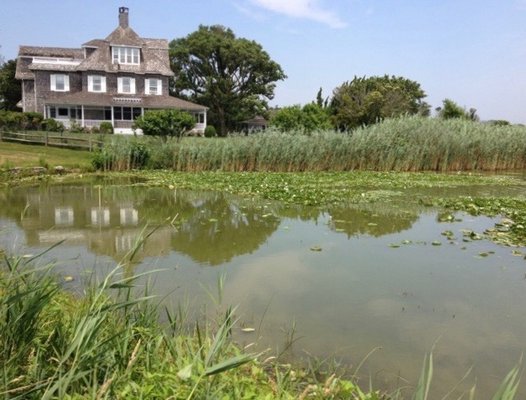
Mocomanto isn’t what most people think of when the talk centers on historic Hamptons houses. The house, named after one of the Native American sachems who sold land to the settlers in 1640, has remained relatively intact over 135 years. Its details are a bit quirky but nonetheless nicely scaled for a summer cottage so clearly representative of its era.
But in 2017, this home in the National Register Historic District of Southampton Village—located in the very core of the Lake Agawam estate section, and highly visible from Gin Lane—is now ripe for the picking.
By today’s inflated standards for summer mansions, Mocomanto simply isn’t big enough, bold enough or tarted-up enough. The ambitious solution to this perceived deficiency is to put the house on steroids.
Its new owner commissioned designer William Sofield to develop plans that will allow for the demolition of more than 40 percent of the existing house, while adding 10 rooms, six bathrooms and an L-shaped connecting wing encompassing a four-car garage and living space off the existing house. Two chimneys will be removed, with the roof being raised 5 feet.
In short, the existing house will be both engulfed and devoured by the additions and renovation.
The theme song for this ensemble will be a play on triangular roof and gable forms, mimicking the original house with a new triangulated hip roof with triangular gable dormers and various displays of symmetrical and asymmetrical massing. The very identity of this iconic home will be lost forever if these proposed changes are approved—and it will set an unfortunate precedent for more of the same by acknowledging that it’s okay to change the character of a historic neighborhood.
All of this, however, is easier said than done. The owner needs approval from the Southampton Village Zoning Board of Appeals for a dimensional variance, a wetlands special permit and a special exception. The existing house sits within the 150-foot setback for existing wetlands, with proposed new square footage also located in the protected wetland zone.
Of particular concern are the effects and impact on Lake Agawam of the additional six bathrooms and stormwater runoff. On May 31, Lake Agawam was declared off limits because of the presence of cyanobacteria from an algal bloom, which is toxic to pets, children, adults and wildlife. The lake is currently on New York State’s 303(d) list of impaired water bodies due to the algal blooms, which reappear with frequency.
Phosphorus and nitrogen from nutrient pollution are the main reasons for these blooms. The additional bathrooms at Mocomanto will increase the wastewater output—and the very nutrients contributing to these algal blooms. Furthermore, the proposed façade elevations don’t even show leaders and gutters to control storm water runoff into the lake. Construction of this magnitude also adds to the risk of erosion and impacts the effectiveness of vegetative buffers to contain nutrient pollution to the lake.
The contextual location and the rich and colorful history of the house—built circa 1880 by patent lawyer Frederic Henry Betts (1848-1905), one of the founders of Southampton’s summer colony—is quite significant.
Frederic and his brother Charles Wyllys Betts (1845-1887), also a lawyer, bought more than 32 acres of land at the southwestern base of Lake Agawam and erected 12 cottages. Charles built some appealing cottages for rental on Gin Lane, while Frederic erected a number of more substantial homes along First Neck Lane. Their family compound, known as the Betts cottages, comprised their real estate holdings around the lake area in the estate section.
Frederic Betts was very actively engaged with improvements in Southampton Village, and ironically was quite concerned with maintaining the health of the lake. Mary Cummings noted in her book “Images of America: Southampton” that Lake Agawam was “considered the crown jewel of Southampton Village.” The lake was an epicenter for activities, including sailing and bicycling.
The Betts family returned from a trip to Italy with a gondola. Mrs. Betts on Sundays could be seen in the gondola with four footmen poling across the lake to services at the Dune Church.
Mocomanto stayed in the Betts family until 1969 and has been sold several times since.
On the western side of the lake, Mocomanto sits in the company of three truly unique houses on First Neck Lane: the James Hamden Robb House (1885), known as the Dolphins, designed by McKim, Mead & White; Goodhue and Louisa Livingston’s Old Trees (1912), designed by architect Goodhue Livingston; and Kenneth O’Brien’s Normandy House, formerly Chateau O’Brien (1925), designed by the École des Beaux Arts-trained Polhemus and Coffin.
Additionally, other Betts houses remain on First Neck Lane including The Clovers (Blue Haven), The Mallows and Bonnie Bourne. Together with many older houses around the lake, they form a greater whole. An assault on one diminishes the value of the group as a whole.
These enormous renovation/additions like the one proposed for Mocomanto very often are land grabs—upgrade and flip. Demolish a historic property, build something twice the size—like what has been proposed for 24-28 Gin Lane—and then flip for twice the price. With no decent land left on which to build, there will be more and more of this happening.
Once upon a time, purchasing a home in a historic district meant that the basic parameters and the houses within would remain relatively intact. What’s really at stake here is maintaining the visual historic equity of the community—and that’s priceless.
Mocomanto is on the agenda for the Southampton Village ZBA meeting on Thursday, June 22, at 7:30 p.m.